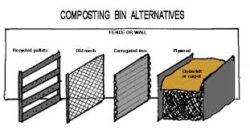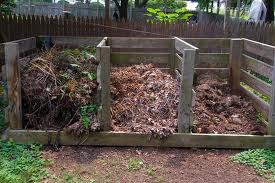With all the leaf raking going on, now may be a good time to consider building a compost pile. Use all those dry leaves and turn them into black gold for your garden beds. This process requires the right ingredients, blended together in the proper balance for this natural process to take place. It will require some of your time and attention to make sure all this is happening properly. Follow the outline below to learn about the basics. If you have questions, stop by Creek Side and consult with one of our Green Team Gardening Experts!
Benefits of Composting
- Composting yard waste recycles nutrients back into the yard and saves landfill space
- Compost can be used as a soil amendment and mulch
Composting Materials
- Recycle yard and kitchen waste
- Brown materials contain less Nitrogen – Dry leaves, straw, small woody twigs, shredded newspaper, coffee filters, tea bags, saw dust
- Green materials contain more Nitrogen – vegetable & flower parts, lawn clippings, weeds, vegetable scraps, coffee grounds
- Avoid animal waste – attracts pests
Making Compost
- Alternate layers of shredded plant materials in 6-8” layers
- Use 3 times as much dry/ brown materials than wet/green materials for each layer
- Shred the materials into a medium size pile – too large is slow to compost, too fine causes matting
- Include small amounts of soil in one of the layers to provide beneficial microbes in inoculate the compost
- Add water to the compost after every series of layers
- A small amount of nitrogen fertilizer like blood meal or lawn fertilizer may be added to active the microbes
Requirements of Composting
- The breakdown of organic waste is a biological process dependent upon micro-organism activity
- Microbes require a favorable balance of temperatures, moisture, oxygen and nutrients to do their job
- Plant digesting microbes operate best in a temperature range of 70 to 140 degrees, which they will create
- Add moisture regularly to maintain composting – damp but not soggy
- Plant particle size affects aeration – large pieces decompose slowly, small pieces restrict air flow
- Turn over the compost pile regularly to provide additional aeration and distribute microbes
- Nitrogen is most important food source for microbes
- Brown/ dry material contains little nitrogen, Green material contains more nitrogen
- 3 parts of brown to 1 part green gives the best balance
- Add high nitrogen fertilizer when green materials scarce
Compost Maintenance
- If compost well maintained will be ready in 4-6 months in Colorado conditions
- Proper moisture and oxygen levels most important
- Water consistently to keep compost moist
- Turn entire mass to provide uniform aeration
- Small amounts of fresh materials may be added
- If enough material is available begin new pile rather than adding to established pile
Compost Locations and Structures
- Partial shade is best
- Protect from drying winds
- Structures very helpful – can be built or purchased
- Covering with plastic holds in moisture – but may limit aeration
- Minimum amount of material required to build up heat – 36” x 36” x 36”
- Plastic or wood structures may be smaller
- Wooden 3 bin system works well for turning pile

